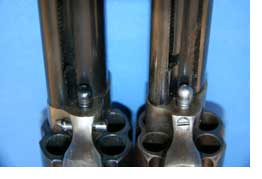
Originally written for the High Noon Western Americana January, 2010 Smoke Signals newsletter and used with permission. By Phil Spangenberger.
Phil Spangenberger writes for Guns & Ammo magazine, appears on the History Channel and other documentary networks, produces Wild West shows, is a Hollywood gun coach and character actor, and is a Field Editor and regular columnist for True West.
Among many Peacemaker fans, there’s a misunderstanding of the terms “black powder” frame or “smokeless” frame, so let’s clear the smoke.
Colts Photo Close-upAmong today’s shooters and Colt Single Action Army (SAA) revolver collectors, we often hear the terms “black powder frame” and “smokeless frame.” These are relatively modern terms (dating from roughly around the mid-20th century when gun collecting was gaining in popularity) and are used primarily to describe the era that a Colt Peacemaker represents. The “black powder” moniker comes from the fact that, the first Peacemaker Colts were made with a cylinder base pin retaining system that used a single screw, located at the front of the revolver’s frame. In 1896, at around serial number 165,000, Colt changed over to the so-called “smokeless” frame, where the cylinder base pin is held in place by spring-loaded cross-pin screws. Ironically, this system has nothing to do with smokeless powder, since Colt did not guarantee any of their 1873 Single Action Army revolvers for use with the then new smokeless propellant until around serial number 180,000 (1898). Furthermore, this system had been employed as early as 1877 and again in 1878, on Colt’s double-action models. It’s simply a modern collectors’ term to differentiate between the two types and/or eras of manufacture of the 1873 Colt SAAs.
The so-called “smokeless” cross-pin system allows for the cylinder to be removed from the frame simply by manually depressing the cross-pin screws, pulling out the base pin, then removing the cylinder, whereas the older single screw system requires a screwdriver to remove the base pin retention screw, then the cylinder. While the more modern system is certainly faster in removing a cylinder, it does present a potential problem. That is if the cross-pin screws loosen up and the base pin slides forward during recoil of the gun, the cylinder can become stuck or actually fall out of the frame. This shooter has had this happen on a number of occasions. On the other hand, as long as the screw in the older black powder frame-type sixgun is firmly in place, this won’t happen. In decades of firing Peacemaker Colts and Colt clones, this gunner has never experienced a malfunction due to this single screw system.
Many SAA shooters also think the term “black powder frame” means one can only fire black powder ammunition in this handgun, and the “smokeless frame” is for use with smokeless ammo. WRONG! With currently produced 1873 SAA Colts or modern replicas of the ’73 Peacemaker, you can fire either black powder or smokeless ammo in either frame style. These frame designations tell which era a particular single action represents. However, if you are working with a vintage Colt SAA, revolvers with serial numbers under 180,000 should only be loaded with black powder cartridges-and then only after having them carefully inspected by a competent gunsmith.
With modern-made arms, Old West enthusiasts wishing to be authentic to the era will probably want the “black powder” frame (1873-1896), while those wishing to represent the end of the 19th century up to modern times, could opt for the so-called “smokeless” frame. Now that you know the difference between the two frame types of peacemaker revolvers (old or new, Colt or replica), what are you waiting for? Skin that smokewagon pardner!
Photo 1: The so-called “black powder” framed Single Action Army revolvers can be readily identified by the location of the cylinder base pin retaining screw, as shown by these genuine Colt Peacemaker examples. The older, circa 1893, black-powder framed sixgun has the single base pin retaining screw located at the forward portion of its frame, while the later, circa 1969, so-called “smokeless” framed sixgun uses a spring-loaded dual screw, cross-pin retaining system. Vintage Colts under approximately 165,000 serial number (around 1896), were made with the black powder frame.
Photo 2: This close up reveals the difference between the older black powder frame (left) with its single base pin retaining screw located at the forward portion of the gun’s frame, versus the more modern smokeless frame dual screw system (right). This newer method uses a dual screw, spring loaded cross-pin setup.

